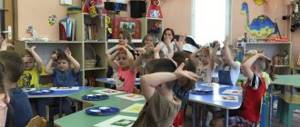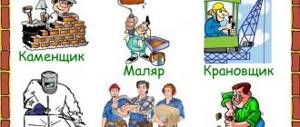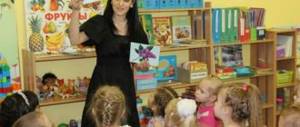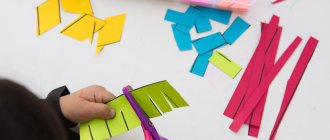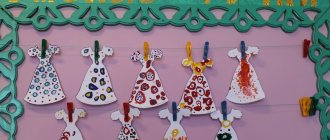Hello, dear colleagues and everyone, all my beloved readers. With you, as always, Tatyana Sukhikh, and today the topic of our discussion is how to conduct a final lesson in the senior group in accordance with the requirements of the Federal State Educational Standard. This question came to our blog from one of the readers and, what can I say, the topic is very relevant. After all, right now our beloved kids are finishing their education in preschool institutions and are about to move on to a new stage of their development - starting school.
We tried for a long time to ensure that this turning point was a joyful event for them and did not cause difficulties. And to show everything that preschoolers have learned in kindergarten groups, there are final open classes, which are usually attended by educators and primary school teachers. Since the question asked did not specify the specific topic of the lesson, I will give several examples of summing up. Namely in mathematics, grammar, ecology and natural history, drawing, as well as physical education.
Grammar Adventures
And again, first of all, we determine the knowledge that your preschooler needs upon completion of training at a preschool educational institution. These include:
- knowledge of letters (alphabet);
- definition of vowels and consonants;
- isolating sounds (letters) from a word;
- selection of words starting with a given letter;
- reading words and simple sentences by syllables;
- understanding the meaning of a sentence (where it begins and ends);
- ability to hold a pen correctly;
- skill of tracing letters along the contour;
- completing speech development tasks.
As for the last point, to help prepare for the lesson, a manual with complex lessons compiled in accordance with the requirements of the Federal State Educational Standard “Formation of coherent speech in children 4-6 years old: planning, lesson notes, lexical material” may be useful.
When compiling notes for a lesson on FEMP, it is worth considering that kids really like to pronounce sounds (letters) using the example of sounds made by animals:
- the cow makes "Moo";
- pig - “Oink-oink”;
- geese - “Ga-ga-ha”;
- ducklings - “Quack-quack-quack”;
- goat “Me-uh”;
- lamb "Be-uh."
Therefore, when going to the country of “Bukvaria” or any other country, as you call it, along the way you can meet different animals and pronounce sounds with them. If you use a CD with animal sounds, the activity will be even more interesting. You can turn on sounds and not just ask the group to pronounce them, but first guess.
Your literacy lesson could be based on the idea that letters have been stolen, and in order to get them back, the children need to go to the fictional country of “Bukvaria”, and then find the stolen alphabet by completing some tasks.
For the lesson, you can make a tree of Knowledge out of paper, on which, according to the scenario, leaves with letters should be hung. But since the Alphabet was stolen, your tree will stand without leaves and the children will have to put all the letters together. They can be hidden similarly to the geometric shapes from the previous math lesson. But let your kids find not all the letters (you will simply put some in a secret place). And after all the found leaves are attached to the tree, your students will need to name the missing components of the Alphabet.
After the guys complete this task, we move on to a more difficult stage - adding syllables from letters. To begin, review the vowels with the children. Remind the kids that vowel letters can be sung: “a-a-a”, “e-e-e”, “e-e-e”, “i-i-i”, “o-o-o”, “u-u-u”, “y-y-y”, “uh-uh”, “yu-yu-yu”, “i-i-i”.
Then line them up on different sides with vowels and consonants. Children will have to find the right pair to make a syllable.
In order to test the reading comprehension skills of your students in accordance with the requirements of the Federal State Educational Standard, write on the board a small and simple text of a letter from the villains who stole the Alphabet and invite the children to read it.
It may be more convenient for you to use cards with this very text, which you will distribute to each participant in the lesson. And let them each read one or two words from the text.
And finally, let's not forget that our tree of knowledge is still missing leaves. We can return them in this way: take the cards with letters hidden in a secret place and come up with words that will be named after these letters. You tell the children a word, they guess what letter it begins with, and you attach this very letter to the tree of Knowledge. This way you will return all the stolen components of the Alphabet to your “Alphabet” and the lesson can be considered completed.
Particular attention should be paid to the final literacy lesson in the speech therapy group. And the guide “Speech Development in Children of Senior Preschool Age” can help with this.
As in the first and second cases, do not forget to take active breaks with group games, dancing or other physical exercises related to the topic of the lesson, so that the kids do not have time to get tired. You can watch the video below for a good example of a literacy lesson. For example, I really liked it and if the opportunity arises, I will definitely try this trip in my group.
Summary of the open final lesson at the preschool educational institution “Children’s book is the best helper!”
- August 17, 2016
Competition “Methodological piggy bank of a teacher - 2016”
Nomination “Methodological piggy bank of a preschool teacher”
Summary of an open final lesson in the middle group of a kindergarten with the involvement of the students' parents, the use of mini-projects (children + parents), the use of a lapbook on the topic - “A children's book is the best helper!”
Goal: Repetition and generalization of acquired skills in the cognitive (experimentation) and artistic-aesthetic (literature, music, drawing) areas.
Tasks:
Educational:
1. To consolidate children’s knowledge about children’s writers and their works (S. Marshak, A. Barto, K. Chukovsky).
2. Strengthen children’s ability to distinguish between genres of children’s literature (fairy tale, short story, poem).
3. Strengthen children’s ability to see a common feature and the ability to group objects according to a specific feature.
4. Strengthen children’s ability to think logically.
Educational:
1. Develop children’s ability to communicate with adults and peers.
2. Develop independence, focus and self-regulation of one’s own actions.
3. Develop responsiveness, curiosity, cognitive motivation.
Educational:
1. Strengthen children’s ability to interact with each other in a short game.
2. Strengthen the ability to follow the rules of the game, line up in a circle, find your place when building, move together, don’t push.
3. Strengthen children’s skills and abilities to carefully use materials and accessories when performing game tasks.
Equipment: Phonogram of the song “Shadow-Shadow-Shadow”, lapbook “Children’s Book”.
Materials:
1. Demonstration: Lapbook “Children's book”.
2. Handout: blanks for each child to draw up an image of the properties of paper, colored pencils, felt-tip pens.
Integration of educational areas: cognitive, artistic and aesthetic education (drawing, literature, music), social and communicative development, physical development.
Preliminary work: reading and listening to children's poems, fairy tales and stories by Russian writers; learning the song and dance “Shadow-shadow-sweat”; viewing portraits of children's authors.
Progress of the lesson
The guys play in a group.
Teacher 1: Guys! Today we have guests. Let's say hello!
Children together with teachers:
Hello, friend, (nods to one neighbor) Hello, friend, (to another) Let's revive our magic circle! Give me your hand and I will give it to you (they extend one hand and the other to the neighbor) And we will have fun. Let us shout together to the whole wide world Sun, hello! Hello guests!
Teacher 1: Dear guests! We are glad to see you in our cozy group.
Parent : Guys, we brought you a surprise, it is in your group, and you must find it yourself!
The teacher organizes the game “FIND WHERE IT’S HIDDEN.”
Objectives: teach children to walk around the entire group, looking for a hidden object, and when they find it, stand next to it. Develop attention and endurance.
(children find a surprise (a bright box), the teacher and the children examine it).
Teacher 1: Guys, what could it be? (Children's reasoning).
Children : Toys, candy, etc.
Educator 2: Oh, so many ideas, what should we do?
Parent : Here's a hint:
Not a bush, but with leaves. Not a shirt, but sewn. Not a person, but talking (Book.)
Together with the teacher, they open the box, and there is a LAPBUK book on the topic “Children's books. Children's writers."
Educator 2 : Guys, look at the unusual pockets in this book! Here is a pocket, and on it is a question mark “?”, what does this mean?
Children: The pocket contains riddles, questions, etc.
Educator 2: Let's try to answer them?
Children : Yes!
Educator 2: What can you find and read in the book?
Children : Fairy tales, stories, etc. You can also find and read rhyming rhymes in books (read one).
Educator 2: How do you think fairy tales differ from stories and poems?
Children : There is magic in fairy tales!
Teacher 2 : Correct! It’s also not without reason that the Russian people say (teachers use a laptop to read sayings about books):
- He who reads a lot knows a lot.
- A book teaches you how to live, a book should be treasured.
- One book teaches thousands of people.
- Reading a good book is not a burden, but a joy.
- The book is your friend, without it it’s like being without hands.
- Reading a book is never boring.
Educator 1 : And in order to open the next pocket, we need to divide into groups according to the cut pictures.
Parents and children are divided into three groups using cut-out pictures.
Pocket “Guess the fairy tale and the author.” The pocket contains illustrations from fairy tales (S. Marshak “Abstracted from Basseynaya Street”; K. Chukovsky “Fedorino’s Mountain”; A. Barto “Toys”), from which children and their parents must guess what work it is and show a portrait of the author.
Teacher 2 opens the “Literary Kaleidoscope” pocket: Now all team members are asked to complete the required word:
- Sivka... (Burka)
- The Little Humpbacked Horse)
- Fedorino... (grief)
- Dr. Aibolit)
- Little Red Riding Hood)
- Zayushkina... (hut)
- Princess Frog)
- The Bremen Town Musicians)
- The Snow Queen)
- Flower... (seven flowers).
Educator 2: Well done, guys!
Educator 2 : And now it’s the other way around: I’ll name the nickname, and you guess who we’re talking about: clubfoot (bear), scythe (hare), gossip (fox), toptygin (bear), patrikeevna (fox).
Educator 1: I wonder what is hidden in this pocket?
Teacher 2 opens the pocket of “Didactic Games” (The pocket contains characters from familiar fairy tales, by which children and parents must guess which of them is the odd one out:
1. Elephant, monkeys, crocodile, fox, telephone.
2. Fedora, cups, table, moydodyr).
3. A cockroach, a sparrow, an elephant sat on a hedgehog, a butterfly.
Educator 2 : What great fellows you all are! But you’re probably tired, so I suggest you do some musical exercises like this!
(The melody “Shadow-Shadow-Shadow” sounds; everyone performs movements together to the music).
(Pocket 4. “Musical exercise”).
BOTH TEACHERS
Pocket 5. “This is interesting!” (Parents introduce children to interesting facts about paper and books) - PARENTS PRESENT PROJECTS.
Educator 1: Guys, this pocket is called “How to properly handle a book,” oh, but it’s empty. How to be? (Children's reasoning).
Teacher 1: Well done, I see you know how to handle a book. But still, I propose to go to our “Science Center” and conduct research and confirm whether we named the rules correctly.
(Each company receives a diagram - tasks for conducting an experiment. Assignment for everyone: conduct an experiment and choose a picture - rules). (Independent work of children and parents in the company).
Experiment No. 1. The paper is wrinkled, now try to smooth out the sheet of paper. Conclusion: You can’t crush books. (Wavy lines).
Experiment No. 2. The paper tears. Conclusion: You cannot tear books (Pieces of paper).
Experience No. 3 . "Water and paper." Conclusion: Paper gets wet, you can’t get books wet (A drop of water).
Experience No. 4. The paper gets dirty. Conclusion: do not handle with dirty hands (Hand with dirty fingers).
Each company presents its findings. Pictures - signs are attached to the book corner.
Educator 2: Guys, we’ve run out of pockets in our book! Did you like it?
Children: Yes!
Sonya V.: Let's have a competition!
Educator 2: Let's compete, who knows more poems?!
(Children and their parents read poetry. Both teams receive refreshments. There is a tea party).
Educators: Read them with adults, take care and store them!
Author: Oksana Vladimirovna Zdorovova and Natalya Ivanovna Osipova, teachers of MBDOU No. 5 “Dolphin”, Sharypovo, Krasnoyarsk Territory.
Integrated final lesson for parents in the senior group
Summary of the integrated final lesson for parents in the senior group “Enchanted Islands”
Integrated final lesson for parents in the senior group “Droplets” Topic: “Enchanted Islands” Purpose: to involve parents in correctional and developmental work with children. Objectives: Educational:
Improve children's ability to differentiate vowels and consonants;
To develop the ability to perform sound analysis of three sound words; Practice dividing words into syllables; Learn to draw a diagram of a composed sentence; Teach children to compose a story based on a series of plot pictures, answer questions; Match adjectives to nouns; Consolidate knowledge about numbers, practice putting them in order; • Reinforce quantitative, ordinal and counting backwards. Reinforce your knowledge of geometric shapes. To develop the ability to distinguish objects by width. Developmental:
Develop logical thinking, attention, intelligence;
Develop the ability to navigate in space, compare objects by size. Educational:
Cultivate interest in educational activities.
Develop the ability to listen to a friend’s answer, develop the skill of self-control and self-esteem. GCD move: Surprise moment:
- Guys, look, the parrot is sitting on a branch of brightly colorful colors!
Let's listen to what he tells us! "Dear Guys! Evil pirates have bewitched our islands. And we ask you to free the inhabitants of our islands from the evil spell of pirates.” The teacher draws attention to the fact that a map is attached to the parrot’s legs that will help find the way to each island. I. The first island is the island of Talking Parrots.
(slide) Now there is silence on the island.
Birds don't sing and don't fly. - How can we help the parrots? (children’s suggestions) 1.D/game “Beaks” The teacher lists the sounds: A, M, S, O... Children show with their palms whether there is an obstacle in the mouth or not when pronouncing a given sound and say this word in chorus vowel or consonant sound 2.D/game “Name the vowel sound in the word” - Only those children who answer: what vowel sound is hidden in the word beetle will go to the island with me? (poppy seed, juice, soup, rice, cat, whale). 3. Sound analysis of the word “Roma” - The guys call the parrot Roma. We will disenchant him if we put out the name ROMA - in sounds. Children lay out the word with chips, sequentially highlighting each sound in the word and giving it a characteristic. 4.D/game “Make a sentence” And all the other birds will come to life if we make a sentence about them and write it down. Children draw a sentence in their notebook: Birds are sitting on a branch. SLIDE Guys, look, we have disenchanted the inhabitants of the island. The parrots tell us: “Thank you!” — I sit down on the chairs with the children. II.
The Island of Enchanted Monkeys awaits us. (draw the children’s attention to the map)
1. Exercise “Answer the questions” - Children who answer the questions set off on their journey: What day of the week is it today? Do you remember how many working days there are in a week? How many days off? What day of the week is the fifth? What is the third day of the week? What day of the week is the seventh? Educator: Guys, how can you make such a long journey? 2. Exercise “Build a raft” You can get to the island by raft. Only a friendly team will be lucky! (image of a raft). Educator: Well, the island is visible in the distance, but there is no raft. You need to build it yourself, from logs of different widths: from the narrowest to the widest. (They built a raft, “sailed”) Educator: However, know: you have to perform different tasks in order to disenchant our island. 3. Exercise “Count” Teacher: Cards with animals and numbers are laid out on two adjacent tables. - You need to take one card with animals and count the number of them, and then find the right number and put it in the pocket under the animals. Educator: Guys, look, the monkeys are jumping on the palm trees. Let's each count to ourselves how many monkeys there are? Child: seven Teacher: Count... Child: One monkey, two monkeys, five monkeys, etc. Educator: Well done! How many palm trees? Child: eight. One palm tree, two palm trees, etc. Educator: Well done! How can we make sure that there are as many monkeys as there are palm trees? Child: We need to add one monkey Teacher: Well done! How many are there? Children: Equally. There are eight palm trees and eight monkeys. Educator: How else can you equalize the number of palm trees and monkeys? 4. D/game “Unenchant” Educator: Guys, to unenchant the residents you need to play with the monkeys. Please note that they have different bow shapes. -Which one is the monkey with the red bow in the shape of a triangle? (blue in the shape of a trapezoid, green in the shape of a rectangle...). Since you completed all the tasks, our island has come to life! III.
Pay attention to the map. “The Island of Lost Friends” has not yet been dispelled. Educator: - Tell me, what is the truth better than a lie?
1.Remember the proverbs and sayings about truth and lies. “Truth does not burn in fire and does not drown in water”, “Truth is more valuable than gold”, “Truth is brighter than the sun”, “Truth is carried out from the bottom of the sea”, “The world is supported by truth”, “Lies have a short life”, “Lies of the world” afraid”, “Lies do not make a person beautiful.” The teacher shows the children a beautiful cup. - Look at the cup that appeared on our island. It will help us understand how truth is better than lies. Tell me what she is like. 2. Word game: “Which cup” (Cup (what?) - fragile, beautiful, new, big, wide, heavy, white, slippery.) Educator: - An amazing story happened to one of the friends of this beautiful fragile cup. Let's get to know her. 3.Work on the story. 1.Looking at the pictures, answering questions. — Who is drawn in the first picture? Think of the name of the boy and the dog. What happened to the cup? - Who is drawn in the second picture? What's on the floor? What do you think the boy’s mother asked? What did he answer? - Look at the third picture, tell me, what did mom do with Bobik? — What was the weather like outside? - Who is drawn in the fourth picture? What is the dog doing? - Look at the fifth picture, where the dog is sitting? Who's looking out the window? - Look at the sixth picture, who came to mom? Why did the son come to his mother? The teacher mixes the pictures and invites the children to put them in the correct order. Children arrange pictures, then answer problematic questions. — Did Dima do the right thing when he said that Bobik broke the cup? - Why did he do this? — How did mom feel when she found out that the dog broke the cup? — Did Bobik understand why he was punished? - How did he feel when he sat under the window? — What did Dima feel when he looked out the window? - Is it good to lie? - Do you think Bobik has forgiven Dima? - Let's play the way Bobik does when he is in a good mood. 4. Physical exercise Bobik Here he is spinning like a top. Bobik, Bobik, crochet tail. Here he flies at full speed, now to the river, now into the yard. He's on duty at the gate - In a word, things can't be done wrong. (Children perform movements according to the text) -Now listen to the story, then you will retell it: “Sasha broke the cup. Sharik was lying on the rug nearby. Mom heard the clink of a cup and came into the room. “Who broke the cup,” mom asked. “This is Sharik,” answered Sasha. Mom got angry and kicked Sharik out into the street. The weather was cold outside. Sharik howled pitifully and asked to go back home. Sasha saw Sharik from the window and said to his mother: “I broke the cup.” 5. Compilation of stories by children. The teacher invites the children to tell the story individually, in pairs, in a chain. 6. Summing up. - Well done boys.
You have some good stories. I hope you understand why the truth is better than a lie. -Look, all our islands are disenchanted. The islanders thank you and give you souvenirs. Presentation on the topic: Integrated final lesson for parents in the senior group
We recommend watching:
Summary of NOD in the senior group “Northern Adventures” Integrated lesson for children of the senior group Integrated lesson with a presentation for children of the senior group on the topic: Autumn Integrated lesson on the development of creative abilities using fairy tales in the senior group
Similar articles:
Summary of an integrated lesson in the senior group of kindergarten. Days of the week
Summary of a lesson in the senior group on the topic “Desert”
Abstract of GCD in mathematics in kindergarten in the senior group. Length, height, width of objects
Summary of an integrated lesson on the topic “Animals” in the senior group
Lesson summary - travel for children of the senior group of preschool educational institutions on the topic: Birds
Final Lessons, page 3
Materials found: 70 Shown: 21 - 30
Summary of the open final lesson in the middle group on the topic “Spring”
Summary of the open final lesson in the middle group on the topic “Spring” Program content: - clarify the characteristic signs of spring; - develop logical thinking; - develop visual and auditory perception, attention, fine...
Visiting a fairy tale. Summary of an open lesson in mathematics (end of the year) II junior group
Summary of an open lesson in mathematics (end of the year) II junior group “Sun” Educator: L. S. Zadorozhnaya Topic: Visiting a fairy tale Objectives: 1. Exercise children to arrange objects in ascending/descending order 2. ...
Final lesson on mathematical development in the preparatory school group: “On a visit to the Mistress of the Copper Mountain”
Municipal Autonomous Preschool Educational Institution Kindergarten No. 5 ZATO Mezhgorye Republic of Bashkortostan Educator: Sazanova N.P. Mezhgorye, 2012 Final lesson on mathematical development in…
Final speech therapy entertainment for preschool children “Holiday of Beautiful Speech”
Ogopedic leisure for children of preparatory groups with the participation of parents “Holiday of beautiful speech” Teachers - speech therapists of MADOU “Joy” Zaugolnykh I. N., Rogova E. A., Styapshina L. N., Gubkinsky Yamalo-Nenets Autonomous Okrug 2012 Target:…
Final lesson in mathematics in the senior group: “Journey with Little Red Riding Hood”
“Journey with Little Red Riding Hood” Final lesson in mathematics in the senior group. Tasks Educational: • To consolidate the comparison of groups of objects by quantity by making pairs using the signs >, <, = • To consolidate…
I am a child... And I have the right... Joint play activities of parents and children.
I am a child …. And I have the right...! Joint play activities of parents and children. (Final event for senior preschool age. This development of a joint event on legal education makes it possible to consolidate…
Summary of the final lesson in cognitive project activity on the topic “Our small Motherland - Dergachevsky district”
Summary of the final lesson in cognitive project activity on the topic “Our small homeland - Dergachevsky district” Goals and objectives: - consolidate children’s knowledge about their native village (symbols, attractions, fellow countrymen, ...
Final lesson on teaching literacy in the preparatory group. "The Adventures of Pinocchio"
Teacher Shatalova Lyubov Nikolaevna, I qualification category. Final lesson on teaching literacy in the preparatory group. “The Adventures of Pinocchio” Program content: - strengthen children’s skills in composing and reading...
Lesson “Dunno visiting the guys”, with children 3–4 years old
Goal: To consolidate children's knowledge about vitamins, vegetables and fruits, and their benefits for humans. Remember the main groups of fire hazardous items, basic safety rules for handling fire and household items. Pin...
Journey to the Far Far Away Kingdom. Lesson in a preparatory group (with video)
Topic: Journey to the Far Far Away Kingdom. Program content: To consolidate with children the knowledge acquired over the year: in counting, in time orientation, in space, orientation on a plane, in solving problems and examples. Pin...
Final lessons - go to the main page of the section.
Pages: 3 …
All sections
